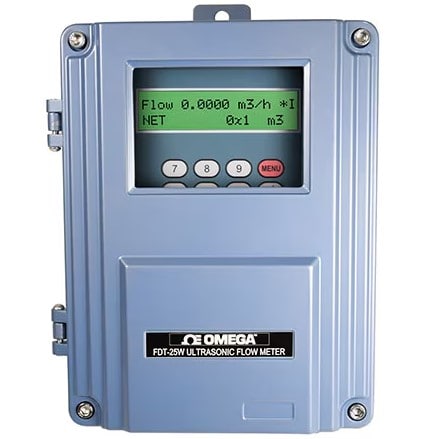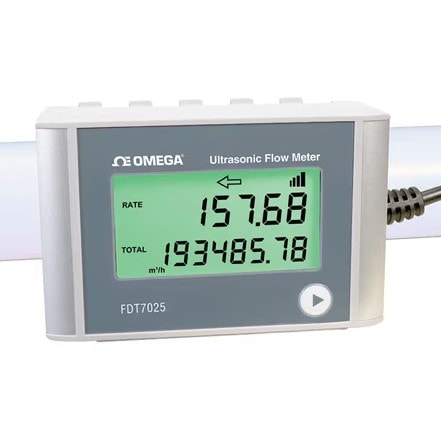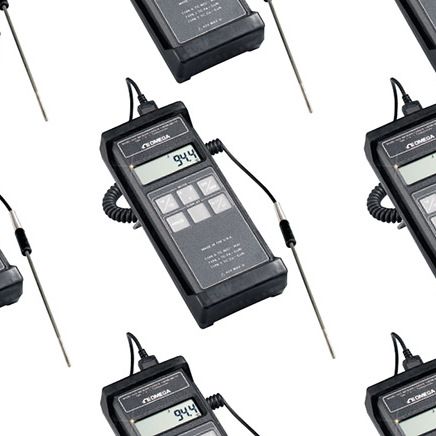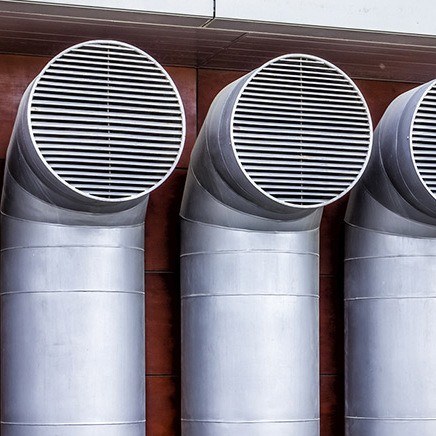Ultrasonic Flow Meters offer a non-invasive, clamp-on solution for measuring fluid flow without interrupting an application process. The two primary types are: Doppler and Transit Time.
While both use high-frequency sound waves to determine flow rate, they rely on different physical principles and are suited to different types of fluids.
Choosing the right technology depends on the characteristics of the application, particularly its clarity and the presence of particulates or bubbles.
What Is a Doppler Ultrasonic Flow Meter?
- Minimum particulates: 80–100 mg/L solids (+75 µm) or 100–200 mg/L bubbles (75–150 µm)
- Ideal for: slurries, wastewater, activated sludge, mining flows
- Not recommended for: clean or bubble-free fluids
Doppler ultrasonic flow meters operate based on the Doppler Effect, first described in 1842 by Austrian physicist Christian Doppler. The Doppler Effect states that the frequency of a sound wave changes depending on the relative motion between the source and the observer. Think of how a car horn changes pitch as it speeds past.
In a Doppler Flow Meter
- A transducer emits an ultrasonic signal into the flow stream
- If the liquid contains suspended particles or air bubbles, these discontinuities reflect the signal
- A second transducer detects the frequency shift caused by the motion of the particles
- The shift is directly proportional to the fluid’s velocity
Flow Velocity Equation
- f0 = Transmitted frequency
- f1 = Reflected frequency
- K = Constant (based on geometry and sound speed)
What Is a Transit Time Ultrasonic Flow Meter?
- Best for: clean, homogenous liquids with no solid/gas contaminants
- Used in: crude oil, viscous fluids, and cryogenics (e.g., LN₂, argon, helium)
- Challenges: may underperform with excessive air bubbles or solids.
- Accuracy: up to ±0.1% if temperature and density are stable
Transit time ultrasonic flow meters operate differently than Doppler ultrasonic flow meters. Rather than relying on sound, they measure how long it takes for an ultrasonic pulse to travel across a pipe—both upstream and downstream.
When flow is present:
- The signal moving with the flow travels faster
- The signal moving against the flow travels slower
- The difference in transit time correlates to flow velocity
Transit Time Velocity Equation
- Vf = Fluid velocity
- K = Calibration factor for volume and time units
- dt = Time differential between upstream and downstream signals
- TL = Transit time at zero flow
Featured Solutions from DwyerOmega
FD-400-Series Doppler Ultrasonic Flow Meter
For applications requiring accurate, non-invasive flow monitoring of liquids containing suspended solids or gas bubbles, the FD-400 Series Doppler Ultrasonic Flow Meter delivers robust, reliable performance across a wide range of industrial environments.
This advanced flow meter measures the velocity of liquids that contain sonic reflectors—such as particulates or entrained air bubbles larger than 100 microns—using the Doppler effect. Ultrasonic signals are transmitted through the pipe wall or probe tip and reflected back by these moving particles. The resulting frequency shift is directly proportional to flow velocity, which the FD-400 converts into user-defined flow units via its integrated LCD display.
Key Features:
- Non-Invasive or Insertion Options: Choose from the FD-400C clamp-on transducer, ideal for metal and plastic pipes without system interruption, or the FD-400I insertion probe, designed for applications where pipe wall penetration is required
- Wide Flow Range: Measures from 0.05 to 9 mps (0.15 to 30 fps) with an accuracy of ±2% FS across the calibrated span
- Flexible Configuration: Front-panel keypad and 2-line backlit LCD allow intuitive setup and real-time monitoring in a variety of engineering units—gallons, liters, barrels, pounds, and more
- Durable Construction: Enclosures rated to NEMA 4X (IP66) for the monitor and NEMA 6P (IP68) for the standard clamp-on transducer ensure long-term reliability, even in harsh environments
- Multiple Outputs: Optional 4-20 mA analog, rate pulse, and dual relays provide seamless integration into existing control systems
- Remote Installation: Transducers can be mounted up to 305 meters (1000 feet) from the display enclosure, making the FD-400 an ideal choice for large-scale or difficult-to-access systems
FDT7000-Series Clamp-On Transit Time Ultrasonic Flow Meter For Clean Liquids
Utilizing transit time ultrasonic technology, the FDT7000 Series delivers accurate, repeatable flow readings—without ever touching the liquid.
The FDT7000 is designed for simple installation and long-term reliability. Its snap-on clamp design eliminates the need for pipe cutting or system downtime, making it ideal for retrofit projects or process upgrades. With no moving parts, pressure loss, or fluid compatibility concerns, this meter is well-suited for a wide range of applications involving PVC-U and PP-R piping systems carrying water-based fluids.
Key Features:
- Non-Invasive Clamp-On Design: Sensors mount externally on the pipe—no process interruption, no contamination risk
- Reliable Accuracy: Measures flow rates from 0.3 to 19 ft/s (0.1 to 6.0 m/s) with ±1.5% full scale accuracy and 0.3% repeatability
- Compact & Durable: Lightweight ABS plastic enclosure rated to NEMA 3 (IP54) withstanding up to 99% RH humidity in non-condensing environments
- Easy Integration: Standard 4 to 20 mA output (for 2" pipes and smaller) and RS485 Modbus® communications for remote monitoring and control
- Efficient Power: Operates on 10 to 36 VDC with a low current draw, simplifying system compatibility
- User-Friendly Interface: Integrated LCD display provides clear flow rate visualization directly on the unit
Connect with a DwyerOmega Expert Today!





